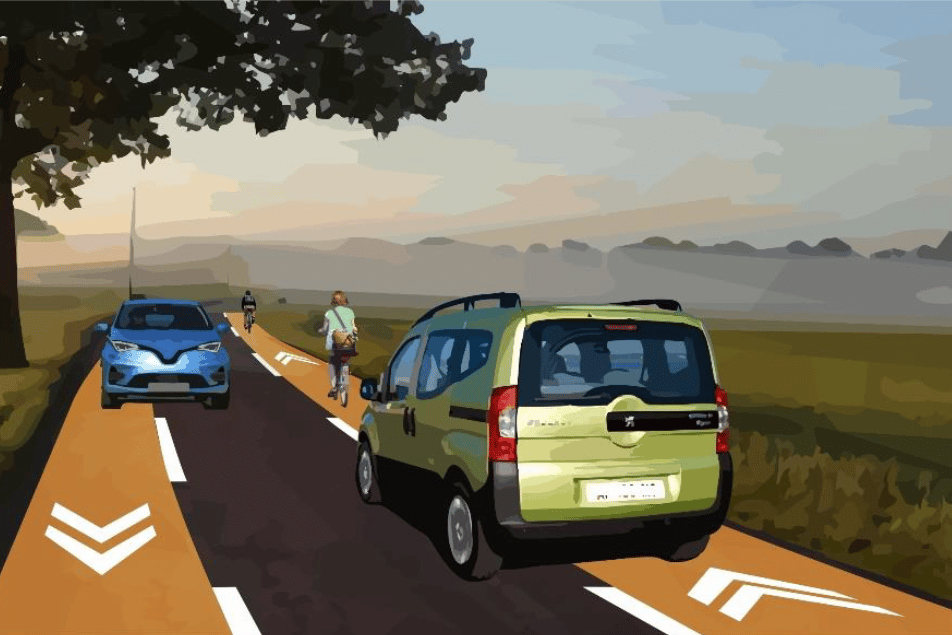Chaucidou, what is this road with bike lanes?

The rise of cycling practice highlights a type of shared lane with other vehicles, the chaucidou. How does it work?
As cycling regains its noble status, urban planning and road infrastructure are evolving with the times. This often involves significant changes, such as the introduction of the chaucidou, a curious type of road or street that has been in the news for the past few months.
What is a chaucidou?
So, what exactly is a chaucidou? This portmanteau word does not exist in the dictionary as such, because it is a contraction of “Chaussée pour les Circulations Douces” (“Road for Gentle Traffic”). It is also spelled “chaussidou” and sometimes referred to as CVCB or “Chaussée à voie centrale banalisée”.
This type of infrastructure is possible on narrow roads – less than 7 meters wide – where adding cycle lanes on the sides or parallel to the existing road is not feasible. It was legislated by the decree 2015-808 of July 2015, which integrated the device into the Highway Code without naming it, with the phrase: “Cyclists may circulate on shoulders equipped with a roadway surface.”
Thus, the chaucidou features cycle lanes merging with the roadway on both sides, marked by ground markings. As a result, the middle lane is designated for motor vehicles — cars, trucks, or motorcycles — while the left and right lanes are for cyclists. All users share the same road.
How to ride on a chaucidou?
Here are the main rules for driving on a chaucidou:
- Cyclists should ride within these dedicated bike lanes.
- Other vehicles must stay on the central bidirectional lane.
But in certain cases, motorized vehicles are required to ride partially on these lanes. Indeed, bicycles have priority.
- Vehicles must overtake a cyclist by passing in the middle of the road, without encroaching on the opposite cycle lane, leaving a gap of 1.50 meters;
- However, dangerous situations can arise when two vehicles — each in a different direction — attempt to overtake a cyclist at the same time. One of the drivers must wait before executing the overtaking maneuver. Common sense suggests that the first vehicle to pass a cyclist should do so safely;
- When two cyclists cross paths, it is also prohibited for a vehicle to overtake and they must veer onto the left cycle lane to give way.
Where can you find a chaucidou?
So, why the sudden interest in the chaucidou? Recently, it has been experimented with on the departmental road D25 between Pierrefitte and Villetaneuse (Seine-Saint-Denis). The trial began in May 2023 and is planned to last for one year.
The first instances of this type of infrastructure appeared in Switzerland in 1997, followed by Germany and the Netherlands in the 2000s. The first example in France was in Mérignac (Gironde) in 2009, as reported by 20 Minutes. Other occasional implementations followed in cities like Albi (Tarn), Les Mureaux (Yvelines), and the Nantes metropolitan area (Loire-Atlantique), which experimented with CVCB in 2014 through Cerema.
The first large-scale trial took place under the name CVCB in Isère, on the Pont du Pavé in 2015. Following the introduction of the 2015 decree (see above), many urban areas adopted the chaucidou, most often in zones with reduced speed limits (30 km/h): Dieppe, Perpignan, Lyon, Lille, and Le Mans, among others.
Also read: Anne Hidalgo wants a “street code” for Paris
This page is translated from the original post "Chaucidou, c’est quoi cette route à voies cyclables ?" in French.
We also suggestthese articles:
Also read






